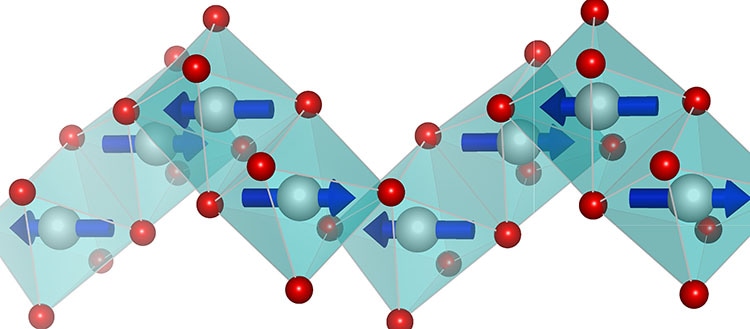May 15 2018
Transitions between varying phases of matter are part of people’s daily lives: for instance, when water freezes, it changes from liquid state to solid state. In addition, some of these transitions could be of a different kind, ensuing from professed topological excitations that cause all the particles to act in harmony.
 The helix structure of BACOVO: the oxygen atoms, represented in red, are organized in octahedra around the cobalt atoms, located at their center. The blue arrows represent the small moments carried by the cobalt atoms, ordered antiferromagnetically along the helical chain. (Image credit: © CEA/CNRS/UGA)
The helix structure of BACOVO: the oxygen atoms, represented in red, are organized in octahedra around the cobalt atoms, located at their center. The blue arrows represent the small moments carried by the cobalt atoms, ordered antiferromagnetically along the helical chain. (Image credit: © CEA/CNRS/UGA)
A research team from the University of Geneva (UNIGE), University Grenoble Alpes (UGA), CNRS, and CEA, along with researchers from the neutronic centers ILL and PSI, has been investigating a one-dimensional quantum material BACOVO, which is not known to the general public. Within this material, the researchers have discovered a new topological phase transition, which is controlled by two different types of topological excitations and not by a single one. Moreover, they were also able to select which of the two sets would govern the other. The results of the study have been published in the journal Nature Physics.
This field of research was based on the 2016 Nobel Prize-winners in physics: David Thouless, Michael Kosterlitz, and Duncan Haldane. The three physicists predicted that a phase transition may be induced by a set of topological excitations in a quantum material. To this end, many theories have been devised regarding these topological excitations, such as the viability of integrating two of them in one material. However, it was not clear whether that is a real possibility, and if so, what would occur?
The researchers from CEA, UNIGE, UGA, and CNRS successfully provided the initial experimental confirmation of the theory that predicts the existence of two concurrent sets of topological excitations and the competition existing between them. All things considered, it is a small revolution in the enigmatic world of quantum properties.
Theory & Experimentation Intimately Linked
The research teams from UGA, CEA, and CNRS were investigating BACOVO (BaCo2V2O8)—a one-dimensional antiferromagnetic material with specific properties.
“We performed various experiments on BACOVO, an oxide characterized by its helical structure,” emphasize Béatrice Grenier, Virginie Simonet, and Sylvain Petit, researchers at the CEA, UGA, and CNRS. “But our experimental results evidenced a puzzling phase transition” – which is why their team called on Thierry Giamarchi, a professor in the Department of Quantum Matter Physics in UNIGE’s Faculty of Science.
Based on their results, we established theoretical frameworks capable of interpreting them. These theoretical models were then tested again using new experiments so they could be validated.
Thierry Giamarchi, Professor in the Department of Quantum Matter Physics
Creating the “Standard Model”
The goal was to understand how the quantum properties of BACOVO act, particularly their topological excitations.
For this purpose, we used neutron scattering, meaning we sent a neutron beam onto the material. The neutrons behave like small magnets that interact with those of BACOVO, according to a strategy “disturb in order to reveal", helping us to understand their properties.
Quentin Faure, Ph-D student at the Institute for Nanoscience & Cryogenics (CEA/UGA) & Néel Institute
When the model created at UNIGE complements the experiment, it becomes the standard model” of the material. Professor Giamarchi ardently points out: “And, in fact, the model we established with Shintaro Takayoshi predicted exactly the outcome seen in the experiment!”
A Material With Unexpected Properties
However, this experiment also revealed a finding that was not expected by the researchers. “After settling on the “standard model” for BACOVO, we observed unexpected properties,” says Shintaro Takayoshi, a researcher in the Department of Quantum Matter Physics in UNIGE’s Faculty of Science. When BACOVO is placed in a magnetic field, it develops another set of topological excitations that are in competition with the first topological excitation, proving theories from the 1970s and 1980s organized around the field unlocked by the work of the Nobel physicists.
“As well as proving the existence of this confrontation between two sets of topological excitations within the same material – an unprecedented event – we were able to experimentally control which set would dominate the other”, says the Genevan researcher.
And that is a first!
Originally a theoretical hypothesis, it turned out to be a validated experiment. The comprehensive analysis of BACOVO performed by the researchers showed that within the same material, two sets of topological excitations come into direct confrontation and govern the state of matter, which varies in accordance with the dominant set, producing a quantum phase transition. The researchers also succeeded in controlling which set of topological excitations prevails, which means the BACOVO’s state of matter can be adjusted at will.
These results open up a whole range of possibilities in terms of quantum physics research. It’s true that we are still at the fundamental level, but it’s through this kind of discovery that we are getting closer every day to applications for the quantum properties of materials… and why not quantum computers!?
Thierry Giamarchi, Professor in the Department of Quantum Matter Physics